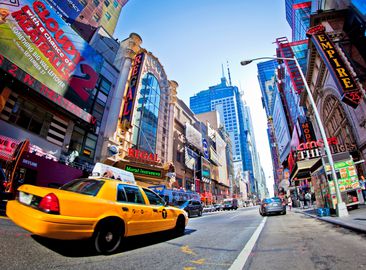

Broadway may be the most famous north-south avenue in Manhattan, but 42nd Street is surely the most popular crosstown street. In fact, at certain points of New York City's history they were considered antipodes: Broadway being the bright and glorious path for aspiring businessmen and entertainers; 42nd Street the dark and despondent lair for pushers and prostitutes.
The street runs from the United Nations Headquarters on First Avenue in the East Side of Manhattan to the Circle Line Sightseeing Cruises ferry terminal on Twelfth Avenue in the West. It is home to some of the most important buildings in the city. Besides the UN complex, which officially stands on international territory, 42nd Street can boast the Tudor City apartment building on First Avenue, the first residential skyscraper to be built in the world; the News Building between Second and Third Avenue, which until 1995 hosted the New York Daily News headquarters and which served as the location for the fictional Daily Planet where Superman has his nine to five job; the Chrysler Building on Lexington Avenue, which was the world's highest skyscraper before the title was overtaken by the Empire State Building; Grand Central Terminal on Park Avenue; the New York Public Library Main Branch on Fifth Avenue; the Bank of America Tower on Sixth Avenue; and the Port Authority Bus Terminal on Eighth Avenue, the largest bus terminal in the US and the busiest in the world for what regards volume of traffic.
However, it is the western half of 42nd Street, the section that starts at Sixth Avenue and runs all the way to the Hudson River, that made the street world-renown. In 1913 the corner of 42nd Street and Broadway became the eastern terminus of the Lincoln Highway, the first road to stretch from east coast to west coast America. Lincoln Highway started on Broadway, ran west along 42nd to the Hudson River, travelers would then cross the river on a ferry and finally, once in Union City, New Jersey, they could proceed cross country all the way to San Francisco. When the Holland Tunnel was built connecting New York to New Jersey underwater, the route of the Lincoln Highway was altered accordingly.
The Lincoln Highway made New York City easily accessible for everyone from America. During the Roaring Twenties, or the Jazz Age, the city was bubbling with new energy and the venturesome spirit, and Times Square was gradually becoming the dazzling heart of New York nightlife. Even during the Great Depression 42nd Street did not lose its joie de vivre and continued pumping vitality into the neighboring streets. The 1933 musical film 42nd Street depicts the glittery theater scene as an incessant longing for fame, fortune and happiness.
By the middle of the 20th century, thanks to the Port Authority Bus Terminal that opened in the 1950, people of all ages, backgrounds and nationalities were flooding New York from the rest of the country, chasing the American dream. New York offered opportunity for all professions and its liberal, tolerant and multi-ethnic environment created a dynamic cultural potpourri. America's victory in WWII and the post-war economic boom boosted the country's morale and made sure the New York theaters were packed with a respectable crowd.
However, 42nd Street had not really changed since the 19th century, when it was the vice hub of the city. New York's best nightclubs, dance halls, brothels, and casinos were all located on or around the street. One policeman even named it the center of the "Tenderloin District" for its superior choice of bordellos. By the late 50s 42nd Street between Seventh and Eighth Avenues was considered the worst block in town. It was swarming with hustlers, low-lives and delinquents. By the 70s, the mood had degenerated even more. And so did the content in the theaters. The sexual revolution had created a demand for a more explicit genre of film and the introduction of cheaper filming techniques paved the way for the rise of the mass market porn movie. When in the mid 70s US legislation permitted the existence of adult theaters, 42nd Street assumed the role of New York's main usher.
By that time the street was called "the Deuce," an informal expression meaning the Devil. Disillusioned by the country's economic decline, more and more people were flocking the street for a cheap thrill. Drug dealers and hookers lined the sidewalks, unabashedly offering their goods. Criminality spread like wildfire. The street's seedy, corrosive atmosphere is perfectly shown in Martin Scorsese's 1976 classic Taxi Driver, starring Robert De Niro. According to statistics, by 1984 there were 2,300 crimes committed annually on the street and in the words of New York's current Police Chief William Bratton, 'the police didn't want high performance; it wanted to stay out of trouble, to avoid corruption scandals and conflicts in the community.' Things were really getting out of hand.
In the late 80s, thanks to the commercial building boom, mayors Ed Koch and David Dinkins started cleaning up 42nd Street. But it was not until the mid-1990s that Italian-American mayor Rudolph Giuliani seriously took up the issue. He increased security, shut down the porn theaters, locked up or just relocated the criminal elements and attracted tourism by offering more wholesome, family oriented entertainment. In just a couple of years the street received a completely new look. Today it is an integral part of the entire Times Square district, offering fun and reputable - although dull and kitschy - shows for people of all ages. It is no longer the notorious 42nd Street, but it certainly makes a walk through the neighborhood safer and merrier.